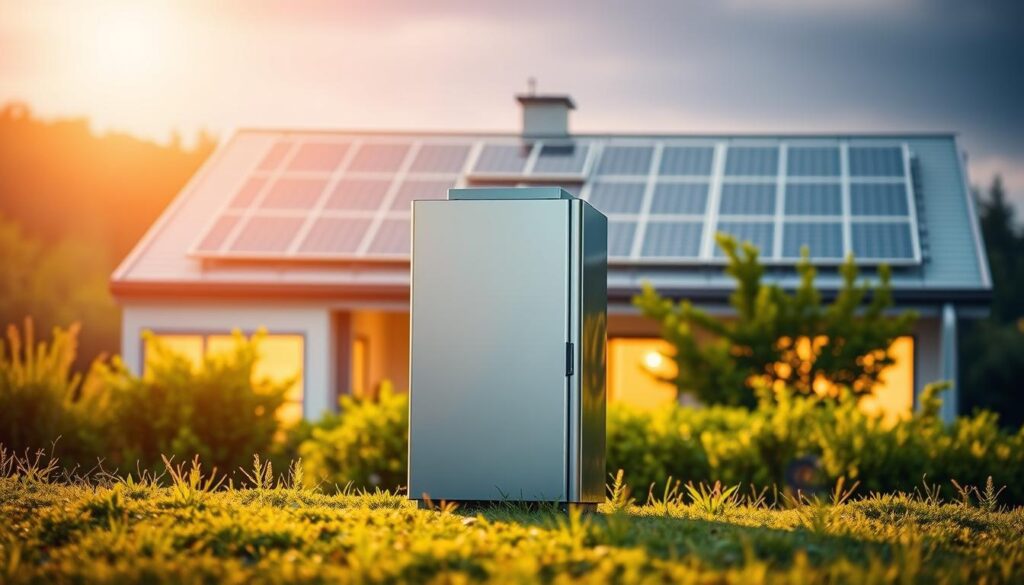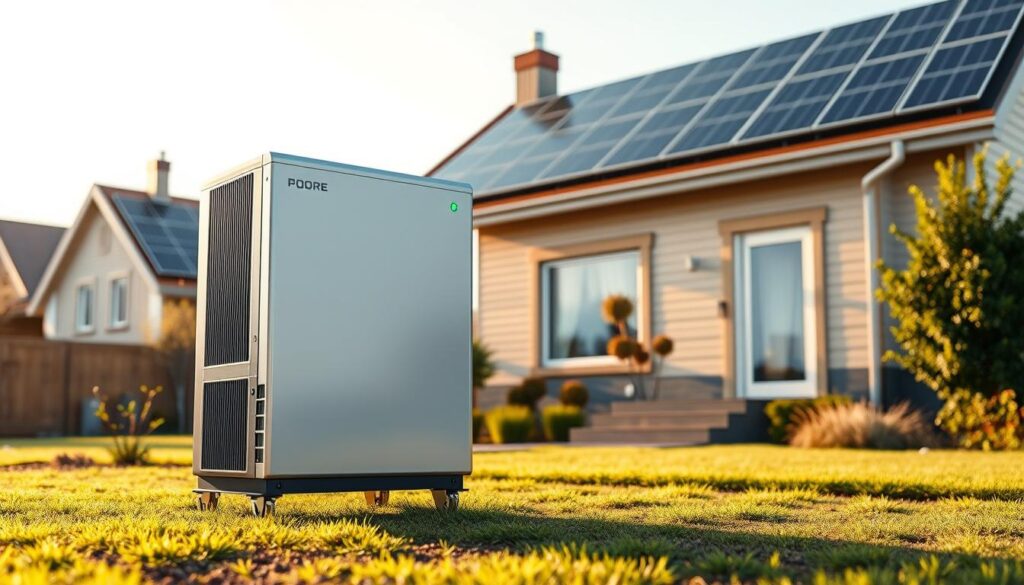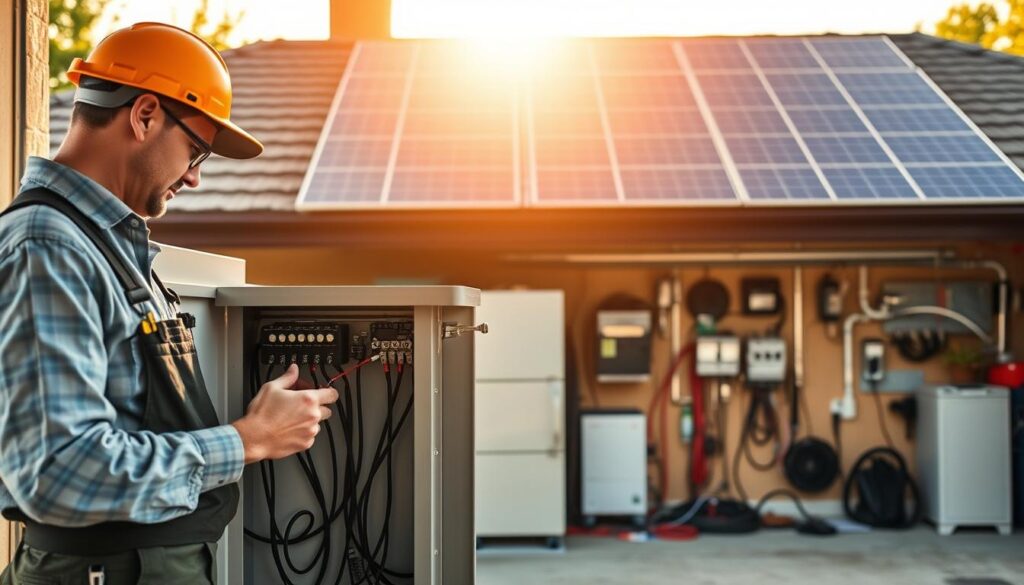Home solar battery backup systems are reshaping how households manage energy. In 2025, the Bluetti EP900 Home Battery Backup outperformed the Tesla Powerwall, offering three capacity options and 9kW output. With 32.5 GW of utility-scale solar expected in 2025, and battery storage expanding by 18.2 GW, these systems are becoming essential for modern homes.
Solar power battery backup solutions like the Bluetti EP900 provide energy security during outages while cutting electric bills. Homeowners using these systems store sunlight energy during the day to use at night or during peak rates. Federal tax credits and state incentives also make solar battery backup more accessible, with up to 30% savings through 2032.
From powering essentials during outages to reducing grid reliance, a reliable home solar battery backup offers long-term value. The right system can last 10-15 years, backed by warranties covering thousands of cycles. Whether choosing a whole-home setup or a partial backup, these systems deliver independence and cost savings.
Key Takeaways
- The Bluetti EP900 is CNET’s top-rated solar battery in 2025, surpassing the Tesla Powerwall 3.
- 32.5 gigawatts of solar capacity will be added in 2025, with battery storage growing by 18.2 GW.
- Home solar battery backup systems can cut electric bills by storing low-cost daytime energy for peak-hour use.
- Investors get a 30% federal tax credit for solar system installations until 2032.
- LFP batteries like the Jackery Explorer 5000 Plus offer 90% depth of discharge and 2000+ cycles.
Understanding Home Solar Battery Backup Systems
A home battery backup system combines solar panels with energy storage for residential solar, ensuring homes stay powered during outages or peak demand. In 2023, 14% of new U.S. solar installations included batteries—a figure projected to jump to 25% by 2024 as demand grows. These systems store surplus solar energy, reducing reliance on grid power and fossil fuels.
What Is a Solar Battery Backup?
A home battery backup system captures unused energy from solar panels instead of sending it to the grid. This stored electricity becomes a reserve for emergencies or high-cost grid hours. For example, a 10kWh battery can power a typical home for a full day without heating/cooling needs.
How Solar Battery Backup Systems Work
These systems operate through two main methods:
- AC coupling: Converts solar energy twice (DC to AC and back), causing minor efficiency loss.
- DC coupling: Minimizes energy loss by keeping power in DC form until use.
Batteries store energy until needed, discharging during outages or peak rate periods.
The Components of a Complete System
Every system requires core parts:
| Component | Function |
|---|---|
| Solar panels | Convert sunlight into electricity |
| Battery | Stores energy for later use |
| Inverter | Converts stored DC energy to usable AC power |
A 30kWh energy storage for residential solar system, for instance, can cover 96% of a home’s needs during a 3-day outage with HVAC use. Proper installation ensures these components work together seamlessly.
The Benefits of Installing a Home Solar Battery Backup
Backup power for home with solar panels transforms everyday energy use. During outages, a house battery backup for solar power keeps essentials like fridges and medical devices running. Imagine avoiding the $2,000+ costs of food spoilage during a Texas-style winter storm—solar batteries offer peace of mind.

- Emergency power during grid failures
- Up to 30% federal tax credit cuts upfront costs
- Reduces peak-hour utility bills by 25–40%
| State | Incentive | Savings |
|---|---|---|
| Washington | Investment Tax Credit | 30% off system cost |
| California | SGIP Rebates | $850–$1,000/kWh |
| Massachusetts | Mass Save | $1,000+/year for energy sharing |
“Solar battery adoption in residential homes could double by 2028, driven by rising energy costs and climate resilience.” – Solar Energy Industries Association
House battery backup for solar power also boosts home value. Studies show solar-equipped homes sell 20% faster and command premium prices. Plus, every kWh stored reduces reliance on fossil fuels—cutting grid-related CO2 emissions by up to 90%.
With 60% of U.S. grid energy still fossil-fuel based, solar batteries align with cleaner energy goals. Even in cloudy climates like Washington, modern panels capture sunlight efficiently, ensuring consistent battery charging. Whether avoiding $15,000 wildfire-related outage costs or enjoying peak-rate savings, the benefits outweigh upfront expenses over time.
Types of Solar Batteries for Residential Use
When selecting the right solar energy storage system, understanding battery types is key. Today’s market offers four main options, each with unique strengths for residential battery backup solutions. Let’s explore which fits your home best.
| Type | Key Features | Lifespan | Cost Range | Best For |
|---|---|---|---|---|
| Lithium-Ion | High efficiency, LFP chemistry preferred | 10–15 years | $5,000–$15,000 | Most homes needing reliable residential battery backup solutions |
| Lead-Acid | Affordable upfront, requires maintenance | 3–5 years | $1,000–$3,000 | Budget-focused users |
| Flow | Scalable, long lifespan | 20+ years | $10,000–$30,000 | Large homes or off-grid setups |
| Sodium-Ion | Emerging tech with abundant materials | 10+ years (projected) | $6,000–$12,000 | Early adopters seeking future-proofing |
Popular brands like Enphase and LG offer LFP batteries, while Tesla’s Powerwall ($16,000) remains a top lithium choice. Flow batteries, though pricier, offer unmatched longevity. Sodium-ion is still rare but promising for cost-conscious buyers.
Choosing the right battery starts with your budget and needs. Lithium-ion balances cost, efficiency, and lifespan, making it a top pick for most homeowners.
Sizing Your Home Solar Battery Backup System
Choosing the right battery size starts with knowing your daily energy needs. Review past utility bills or use an energy monitor to track average daily usage. A typical home uses around 10 kWh daily, but critical loads like refrigerators and lights might require 3-5 kWh.
Calculating Your Energy Needs
Use this formula: Battery storage capacity = (Daily Energy Consumption) / (DoD × Days of Autonomy). For example, a 10 kWh daily need with 50% DoD and 3 days autonomy requires a 60 kWh off-grid solar battery system. FranklinWH’s 13.6 kWh modules can be expanded up to 204 kWh for larger homes.
Battery Capacity vs. Power Output
- Lithium batteries at 80% DoD: 10 kWh x 1.05 inefficiency = 10.5 kWh usable
- Lead-acid at 50% DoD: 24 kWh x 1.2 inefficiency = 28.8 kWh total
A 10 kWh lithium battery with 5 kW output can power a fridge (1 kW) for 10 hours but may struggle with multiple devices at once. Check peak power needs to avoid overloads.
Planning for Critical vs. Whole-Home Backup
Partial backup systems focus on essentials like refrigerators and routers, costing $12,000–$15,000. Whole-home setups need 600–800 amp-hours at 48V and can exceed $20,000. Most homeowners opt for partial backup to balance cost and reliability. For instance, a 14.8 kWh lithium system pairs with a 4.8 kW solar array for moderate needs.
Best Home Battery Backup for Solar Panel Systems
Choosing the best home battery backup for solar depends on your energy needs and budget. CNET’s 2025 top pick, the Bluetti EP900, offers modular setups from 10 to 18.6 kWh with 9kW output. Its versatility makes it ideal for partial or whole-home setups. For those prioritizing power, the Tesla Powerwall 3 delivers 11.5kW output paired with 13.5kWh capacity. A 10-year warranty and scalability up to 4 units make it a reliable solar power battery backup option.

- Enphase IQ 5P provides 5kWh in a compact design with a 15-year warranty, great for smaller homes.
- Generac PWRcell scales from 9kWh to 36kWh in modular cabinets, offering unmatchedless flexibility.
- SolarEdge Home Battery includes an unlimited cycle warranty, reducing long-term costs.
When selecting, compare capacity, output, and scalability. The solar power battery backup you choose should align with daily energy use and outage needs. Check manufacturer warranties and integration with your solar setup. For example, the Bluetti EP900’s transparent pricing contrasts with Tesla’s premium positioning. FranklinWH’s 13.6kWh model with a 12-year warranty is also gaining traction, claiming 10% market share in 2024. Whether prioritizing power, space, or cost, these options balance performance and affordability for modern homes.
Installation Process and Considerations
Installing a home solar battery backup system requires careful planning to ensure safety and efficiency. From choosing installation methods to complying with local rules, each step impacts system performance. This guide breaks down key decisions to simplify your project.

Professional vs. DIY Installation
Many residential battery backup solutions now offer DIY-friendly options. Modular systems like the Anker Solix or EcoFlow Delta Pro Ultra simplify setups with plug-and-play designs. However, whole-home systems like the Tesla Powerwall often need licensed electricians. Key factors include:
- Professional installers handle high-voltage wiring and grid connections
- DIY kits work best for small-scale or expansion projects
- Lithium Iron Phosphate (LFP) models are lighter, reducing labor costs
Permits and Regulations
Local codes can add months to your timeline. For example, some regions mandate fire sprinklers for systems over 20kWh—even for safe LFP batteries. Common requirements include:
- Building permits and electrical inspections
- Utility company approvals for grid-tied systems
- Fire and safety compliance certifications
One homeowner faced a six-month wait due to permit delays, highlighting the need to start early.
Integration with Existing Solar Systems
Pairing batteries with existing solar panels requires matching voltages and inverters. AC-coupled setups work with older PV arrays, while DC-coupled systems optimize energy flow. Key tips:
- Use the same brand for seamless compatibility (e.g., Enphase or Fronius)
- Upgrade to three-phase inverters for high-power homes
- Leave space for future expansions with modular designs
Proper integration ensures your home solar battery backup maximizes energy savings and grid independence.
Cost Analysis of Residential Battery Backup Solutions
Understanding the financial side of energy storage for residential solar starts with knowing what to expect. While upfront costs vary, most systems fall between $12,000 and $22,000. Let’s break down how these numbers add up.
Initial Investment Breakdown
Prices depend on battery type and capacity. For example:
- Enphase Energy IQ Battery 5P: $3,290 for 5 kWh
- Tesla Powerwall: $9,300 for 13.5 kWh
- FranklinWH aPower FHP: $6,722 for 9.6 kWh
Installation adds $3,000+ for labor and permits. Lithium-ion systems often cost $1,000–$2,000 per kWh, while lead-acid options may save upfront but lose longevity.
Federal and State Incentives
A 30% federal tax credit cuts system costs significantly. For a $33,000 setup, this reduces costs to $23,000 before state programs.
States like Massachusetts offer 0% interest loans for solar upgrades. Check local rebates for extra savings.
Long-Term ROI and Savings
Over 10 years, savings stack up. Virtual power plant programs can earn $2,000+ yearly for sharing stored energy. A $33,000 system might net $15,000 in total savings after incentives and income. Factor in monthly energy use—30 kWh daily is typical—for sizing the right off-grid solar battery system.
Maintaining Your Off-Grid Solar Battery System
Maintaining your off-grid solar battery system ensures it runs efficiently for years. Modern house battery backup for solar power systems like those using lithium-ion or LFP chemistry need little hands-on work, but regular checks keep them in top shape. Start with the free app that came with your system—like Enphase Enlighten—to track energy use and battery health. These apps often include features like storm guard mode, which automatically charges batteries before bad weather.
- Check electrolyte levels in flooded batteries and refill with distilled water if needed.
- Use a hydrometer to measure specific gravity. Aim for 1.265–1.275 at 25°C (77°F). Adjust readings using the formula (0.595 × temp – 12.5)/1000 if temps vary.
- Clean solar panels to remove dust, which boosts energy capture by up to 15%.
- Inspect terminals for corrosion. Wipe with a wire brush and baking soda solution if needed.
“A full charge every 3 weeks prevents internal corrosion and extends battery life,” states the National Renewable Energy Laboratory.
Seasonal adjustments matter. Before winter, ensure batteries are fully charged and insulated. In summer, confirm they stay under 40°C to avoid overheating. When away for weeks, set the system to “Full Backup” mode and disconnect non-essential loads.
Professional inspections every year are key. Technicians check for sulfation in lead-acid batteries and verify wiring. Always follow the manufacturer’s guidelines—for example, Rolls batteries require specific gravity checks at 25°C. Avoid over-discharging batteries below 50% capacity to prevent irreversible damage.
With these steps, your system stays reliable. Prioritize routine checks and smart app use to maximize the 5–15 year lifespan of your investment.
Conclusion: Is a Home Solar Battery Backup Right for You?
Deciding on a home solar battery backup depends on your unique needs. If you live in areas like California, where wildfires and outages are common, these systems offer reliable backup power for home with solar panels. A Tesla Powerwall, for example, can power essentials for seven days during blackouts. For larger homes, FranklinWH systems stack up to 15 aPower batteries, offering 204 kWh total storage.
Costs vary—starting at several thousand dollars—but incentives like tax credits offset upfront expenses. Over time, reduced utility bills and participation in virtual power plants can recoup costs. Lithium-ion systems last 5-15 years, and models like aPower’s 13.6 kWh unit pair well with solar panels to cut energy costs. Compare this to generators, which require fuel and maintenance but handle high loads better.
Ask yourself: Do frequent outages disrupt your lifestyle? Does reducing energy bills align with your goals? With eco-friendly options and evolving tech, solar batteries offer long-term value. Start small with modular systems if budget is a concern. Research local incentives and consult professionals to align your choice with home needs. The right home solar battery backup balances peace of mind with smart investment.
